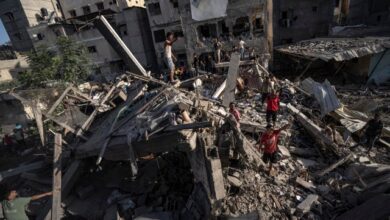Dams in Libya that caused floods have long-standing cracks
An official said that two dams that collapsed in a hurricane-force storm and unleashed a wall of water that killed thousands of people in the Libyan port of Derna had been weakened since 1998.

An inquiry into the events leading up to the collapse, which resulted in the devastating flash flood that swept across the city on Sunday, has been announced by prosecutor general Al-Seddik Al-Sour.
The two dams that had been constructed to keep water from Derna in through years of neglect, violence, and division in chaos-ridden Libya fell into ruin, much like most of that country’s aging infrastructure.
The nation of North Africa is now governed by two competing governments that have fought for control ever since the NATO-backed revolt that overthrew and executed longtime tyrant Moamer Kadhafi in 2011 brought about his downfall. A truce from 2020 has mainly held.
Storm Daniel made landfall in eastern Libya on September 10, causing heavy rain to pour in the highlands above Derna.
Cracks
The first dam to collapse was the Abu Mansur dam, which was located 13 kilometers (just over nine miles) from the city and whose reservoir contained 22.5 million cubic meters (almost 800 million cubic feet) of water.
The second dam, Al Bilad, which had a capacity of 1.5 million cubic meters and was just a kilometer away from the coastal city, was then breached by the flood. The typically dry wadi or riverbed that runs through the center of the city was wiped clean by the wall of water and debris.
According to Sour, a Yugoslav corporation built the dams in the 1970s, “not to collect water but to protect Derna from floods.” Derna saw a number of significant floods from the river in the middle of the 20th century before the dams were erected.
The prosecutor for Libya said that both dams had flaws in them when they were first managed there in 1998.
The damage was evaluated by an Italian engineering company that the Libyan government engaged two years later. According to Sour, the report verified the flaws and suggested building a third dam to safeguard the city.
‘Procrastination’
Kadhafi’s administration contracted a Turkish business to do repairs in 2007.
However, because to funding problems, the business did not start the project until October 2010, and it was completed less than five months after the revolution that brought down Kadhafi.
Since then, a budget has been set aside each year to rebuild the two dams, but an official claims that none of the succeeding administrations since 2011 have actually started the job.
Officials from the Libyan audit office criticized “procrastination” in starting the two dams’ repairs in a report dated 2021.
Abdel Wanis Ashour, an engineer and professor, forewarned in a research published in November 2022 that Derna would face a “catastrophe” if the government did not do dam repairs.
Despite Libya having the largest oil reserves in Africa and plenty of other resources, the warning went unheeded.
Petteri Taalas, director-general of the World Meteorological Organization, noted that if the war-torn nation’s early warning and disaster management systems had operated well, many lives would have been prevented.
“They could have issued the warnings and the emergency management forces would have been able to carry out the evacuation of the people, and we could have avoided most of the human casualties,” he said.







